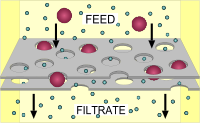
Photo from wikipedia
Abstract As wastewater processing facilities deal with increasing amount in combination with enhanced environmental pressures, diatomite precoat filtration is becoming one of the promising methods for wastewater treatment. Filtration performance… Click to show full abstract
Abstract As wastewater processing facilities deal with increasing amount in combination with enhanced environmental pressures, diatomite precoat filtration is becoming one of the promising methods for wastewater treatment. Filtration performance of diatomite precoat filtration with five different coating layer thicknesses for wastewater treatment was investigated in terms of permeate flux, fouling grade, filtration resistance, permeate quality and fouling reversibility. Pollution mechanism was revealed by fitting Hermia’s fouling models, detecting the pollutant transport and analyzing the changes in microstructure of diatomite. The optimal thickness of diatomite precoat filtration was 4 mm, which exhibited that the highest average permeate flux was 16.53 L/m2h, total fouling resistance reduced by 59.5%, and lowest cake water content was 55.1%. Contact angle measurement indicated that the fouling formed on the diatomite coating layer was highly reversible. Compared with individual fouling model, the combination of three Hermia’s fouling models at different stages fitted the flux data well. FESEM images of diatomite particles confirmed high filtration flux and supported the pollutant transport results. The superiority of diatomite precoat filtration in improving filtration performance and mitigation fouling was demonstrated. The present study could also provide an experimental basis for optimizing precoat filtration process.
Journal Title: Chemical Engineering Research and Design
Year Published: 2018
Link to full text (if available)
Share on Social Media: Sign Up to like & get
recommendations!